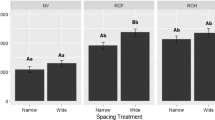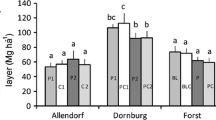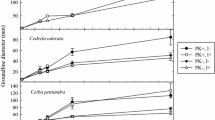Abstract
Shifting cultivators in Thailand widely attribute the maintainance of crop productivity to pada (Macaranga denticulata (Bl.) Muell. Arg.), rotation cycles having become much shorter than the customary 10–20 years. This paper examines the use of pada in a 7-year rotation on an acid soil with low available soil P (2–4 mg kg−1 by Bray II). Dense pada patches in 7-year-old fallow averaged 43 tons ha−1 of above ground biomass, 20% more than sparse patches. The biomass in dense pada contained disproportionately more P, K, Ca and Mg (34%, 92%, 80% and 107% more, respectively) than in sparse pada patches. Slashing and burning 7-year-old fallow with dense pada produced a subsequent rice yield that was three time that with sparse pada. Rice grown after dense pada had been slashed and burned after three years yielded less than one third of that after a full 7-year rotation. It is, as yet, unclear how rice yield in dense pada patches is enhanced in the full 7-year rotation. Nutrient concentrations in the mature rice were generally either the same or higher in the sparse than dense pada patches. In dense pada patches rice accumulated twice to four times as much nutrients as in sparse pada patches, and a much larger fraction of the nutrients was stored in the fallow. Uptake of nutrients in the sparse pada patches may have been limited by some factor that either governs availability of the nutrients released by burning or depressing rice growth and so its nutrient demand.
Similar content being viewed by others
References
Kaya B. and Nair P.K.R. 2001. Soil fertility and crop yields under improved-fallow systems in southern Mali. Agrof Syst 52: 1–11.
Kwesiga F. and Coe R. 1994. The effect of short rotation Sesbania sesban planted fallows on maize yield. For Ecol Mgt 64: 199–208.
Kunstadter P. 1978. Subsistence agricultural economics of Lua' and Karen Hill Farmers, Mae Sariang District, Northwestern Thailand. In: Kunstadter P., Chapman E.C. and Sabhasri S. (eds), Farmers in the Forest. The University Press of Hawaii, Honolulu, pp. 71–133.
Mafongoya P.L. and Nair P.K.R. 1997. Multipurpose tree prunings as a source of nitrogen to maize under semiarid conditions in Zimbabwe. Part 1. Nitrogen-recovery rates as influenced by pruning quality and methods of application. Agrof Syst 35: 31–46.
Nye P.H. and Greenland D.J. 1964. Changes in the soil after clearing a tropical forest. Plant Soil 21: 101–112.
Rerkasem K. and Rerkasem B. 1995. Montane mainland Southeast Asia: agroecosystems in transition. Global Environmental Change 5: 313–322.
Reuter D.J., Edwards D.G. and Wilhelm N.S. 1997. Temperate and tropical crops. Plant Analysis, an Interpretation Mannual.: 81–285.
Sanchez P.A. 1976. Properties and Management of Soils in the Tropics. John Wiley & Sons New York, New York, 618 pp.
Sabhasri S. 1978. Effects of forest fallow cultivation on forest production and soil. In: Kunstadter P., Chapman E.C. and Sabhasri S. (eds), Farmers in the Forest. The University Press of Hawaii, Honolulu, pp. 160–184.
Tarawali G. 1991. Effect of Stylosanthes fodder banks on grain yield of maize. Trop Grass 25: 26–31.
Wanatabe F.S. and Olsen S.R. 1962. Colorimetric determination of phosphorus in water extracts of soil. Soil Sci 93: 183–188.
Whitmore T.C. 1982. On pattern and process in forests. In: Newman E.I. (ed.), The Plant Community as Working Mechanism: Special Publication of the British Ecological Society Produced as a Tribute to A.S. Watt. Blackwell Scientific Publication, Oxford, pp. 45–59.
Youpensook S., Lumyong S., Yimyam N. and Dell B. Biodiversity of Arbuscular mycorrhizal fungi from rhizosphere of Macaranga denticulata (Euphorbiaceae) on the highland rotational shifting cultivation area in Thailand. Aust. J. Botany (in press).
Zinke P., Sabhasri S. and Kunstadter P. 1978. Soil fertility aspects of the Lua forest fallow system of shifting cultivation. In: Kunstadter P., Chapman E.C. and Sabhasri S. (eds), Farmers in the Forest. University Press of Hawaii, Honolulu, pp. 134–159.
Author information
Authors and Affiliations
Corresponding author
Rights and permissions
About this article
Cite this article
Yimyam, N., Rerkasem, K. & Rerkasem, B. Fallow enrichment with pada (Macaranga denticulata (Bl.) Muell. Arg.) trees in rotational shifting cultivation in northern Thailand. Agroforestry Systems 57, 79–86 (2003). https://doi.org/10.1023/A:1023949628251
Issue Date:
DOI: https://doi.org/10.1023/A:1023949628251




